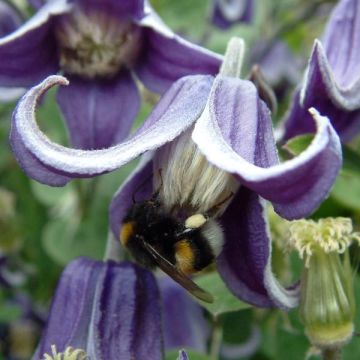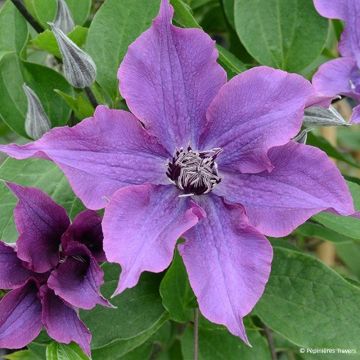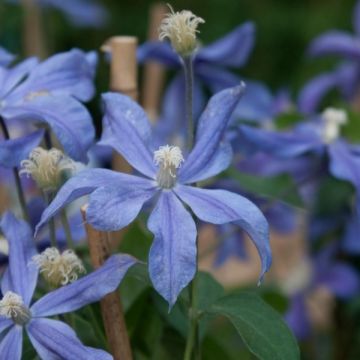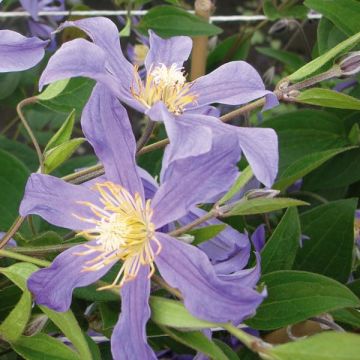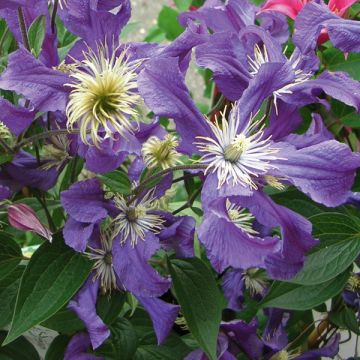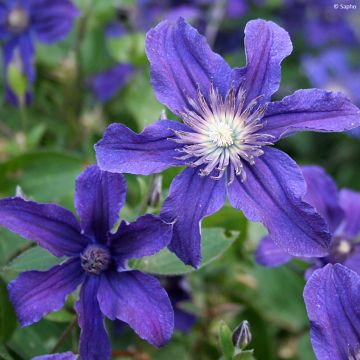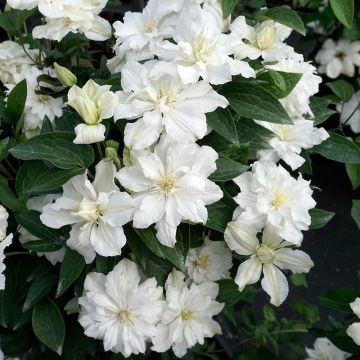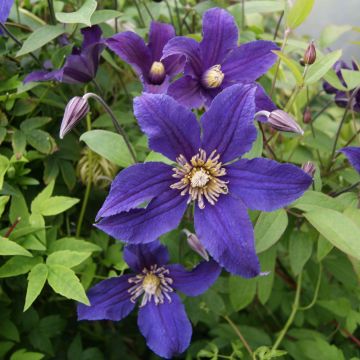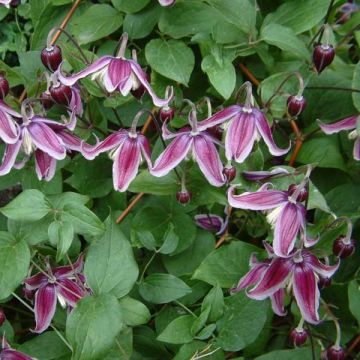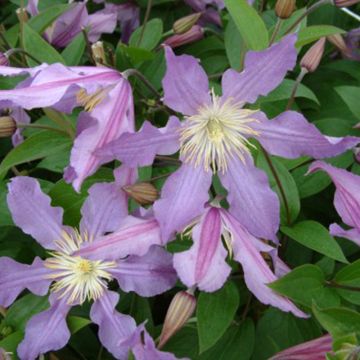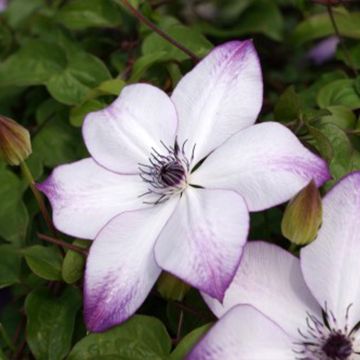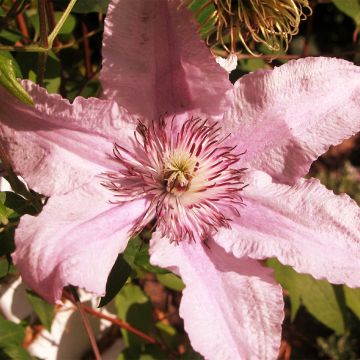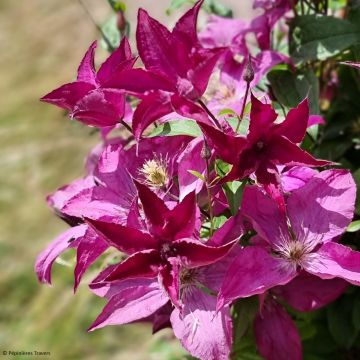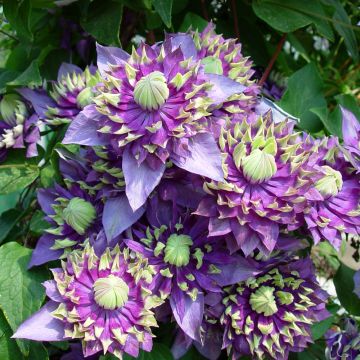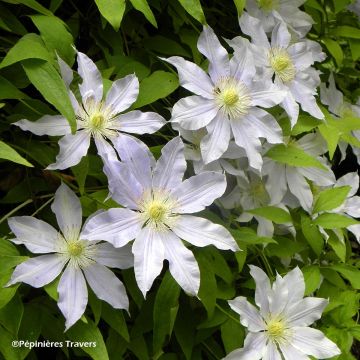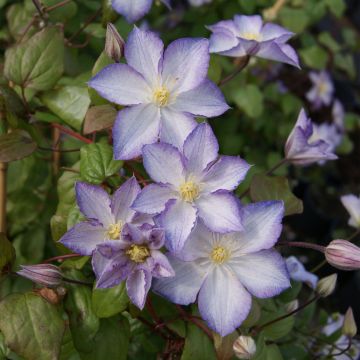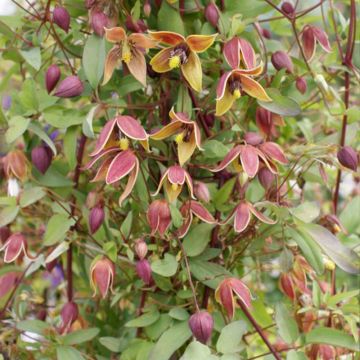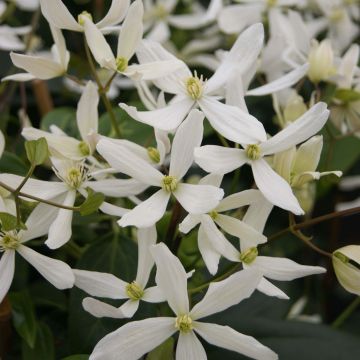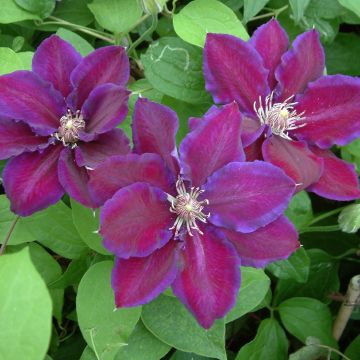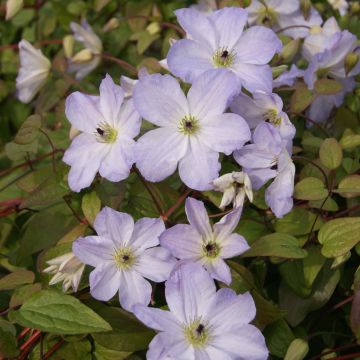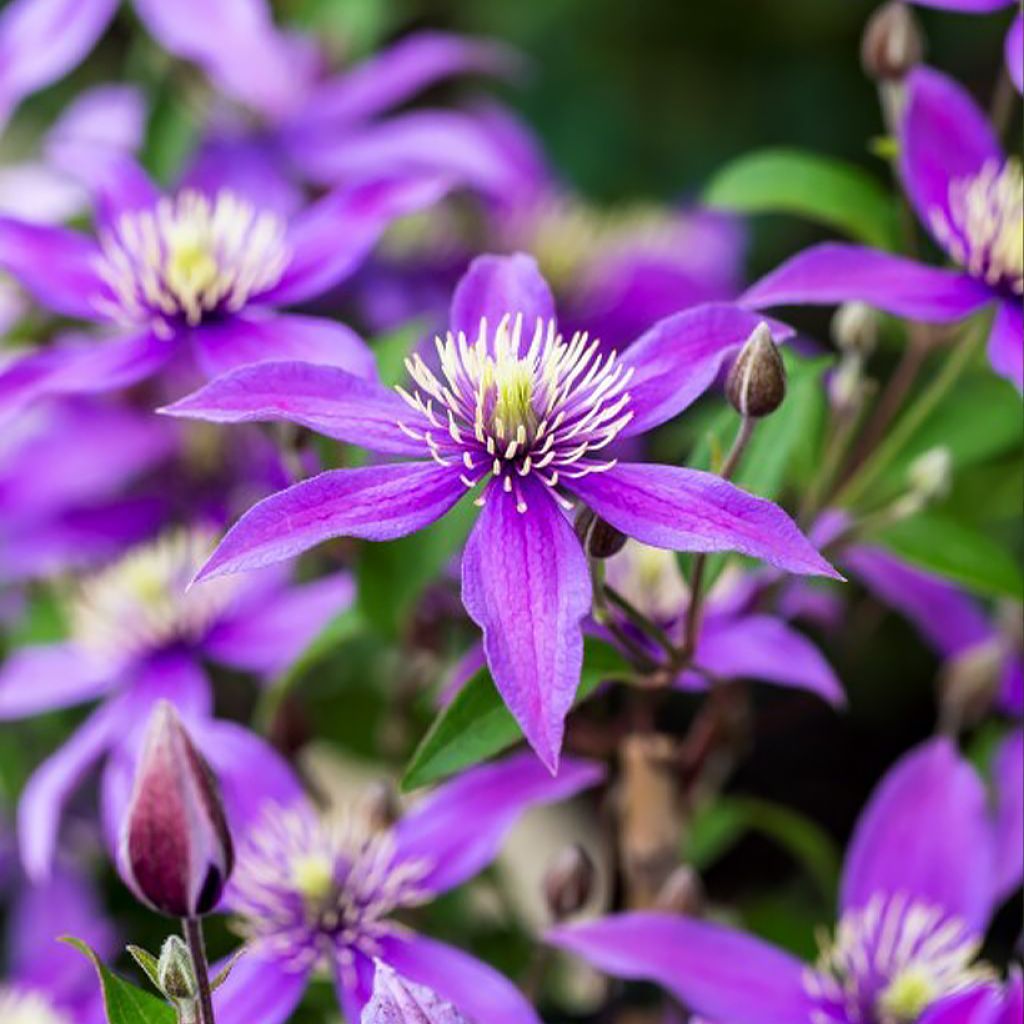

Clematis diversifolia Stella Bella
Clematis diversifolia Stella Bella
Clematis x diversifolia 'Zo23005' (STELLA BELLA)
Virgin's Bower, old man's beard
This item cannot be shipped to the selected country
Delivery charge from €5.90
More information
Schedule delivery date,
and select date in basket
This plant carries a 6 months recovery warranty
More information
We guarantee the quality of our plants for a full growing cycle, and will replace at our expense any plant that fails to recover under normal climatic and planting conditions.
From €5.90 for pickup delivery and €6.90 for home delivery
Express home delivery from €8.90.
Does this plant fit my garden?
Set up your Plantfit profile →
Description
Clematis Stella Bella, belonging to the group of diverse clematis, is used more as a perennial plant than as a climber. Throughout the summer, its numerous flowers bloom in a blue shade with hints of purple. In the centre of each flower there is a bright crown of light yellow stamens. This semi-climbing, modest-sized plant thrives on trellises, fences, or at the base of a bush, but also as ground cover at the foot of trees. It is ideal in a pot on a terrace. Its flowers last several days when cut and arranged in a bouquet.
Clematis are bushy, perennial, or climbing plants from the buttercup family, found in both hemispheres, particularly in Europe, the Himalayas, China, Australia, and North and Central America. It is a genus that offers a wide diversity of flower colours, shapes, and sizes. The Stella Bella variety is a recent creation from the J van Zoest BV nurseries located in Boskoop, Netherlands, derived from Clematis diversifolia. This herbaceous, semi-climbing perennial plant grows to 1 to 1.50 m in all directions. From June to September, you can admire its 8 to 10 cm diameter flowers resembling small windmills. Each flower consists of 6 distinct, slender, slightly incurved tepals surrounding a prominent heart of pale yellow, even cream-coloured stamens. When cut before fully blooming, the bluish-purple flowers last well in a vase. They are followed by feathery, decorative, silver-grey seed heads that persist until winter. The green leaves are deciduous and disappear in winter.
The semi-climbing 'Stella Bella' clematis can be used as a perennial plant in a rock garden, flower bed, or mixed border. Let it grow freely among the branches of a late-flowering bush like 'Zhemchuzhina' Lilac with light violet-pink flowers or the 'Frosty Morn' Mock Orange with double flowers. It also performs well in a container on a balcony or terrace. In a romantically styled flower bed, pair your clematis with a white-flowering shrub rose like 'Nevada' with single flowers or 'Waterloo' with double flowers, and at their feet, plant a 'Crystal Lake' Wallich's Cranesbill with pale mauve flowers veined with violet.
Report an error about the product description
Plant habit
Flowering
Foliage
Botanical data
Clematis
x diversifolia
'Zo23005' (STELLA BELLA)
Ranunculaceae
Virgin's Bower, old man's beard
Clematis intermedia, Clematis x eriostemon
Cultivar or hybrid
Other Clematis Diversifolia
Planting and care
Clematis 'Stella Bella' will appreciate a sunny exposure or light shade. It should be planted in spring or autumn, 5 cm deep, with the root ball laid flat on the soil instead of vertically as usual. The head in the sun and the foot in the shade. Cover the base with a small mound of soil to encourage new shoots. After planting, prune the stems to 30 cm from the base, above a pair of buds. Train them loosely to help the plant cling on its own later. Subsequent pruning in March, will involve cutting back all the previous year's stems to 20 cm from the ground and above a pair of buds.
Planting period
Intended location
Care
This item has not been reviewed yet - be the first to leave a review about it.
Clematis
Haven't found what you were looking for?
Hardiness is the lowest winter temperature a plant can endure without suffering serious damage or even dying. However, hardiness is affected by location (a sheltered area, such as a patio), protection (winter cover) and soil type (hardiness is improved by well-drained soil).

Photo Sharing Terms & Conditions
In order to encourage gardeners to interact and share their experiences, Promesse de fleurs offers various media enabling content to be uploaded onto its Site - in particular via the ‘Photo sharing’ module.
The User agrees to refrain from:
- Posting any content that is illegal, prejudicial, insulting, racist, inciteful to hatred, revisionist, contrary to public decency, that infringes on privacy or on the privacy rights of third parties, in particular the publicity rights of persons and goods, intellectual property rights, or the right to privacy.
- Submitting content on behalf of a third party;
- Impersonate the identity of a third party and/or publish any personal information about a third party;
In general, the User undertakes to refrain from any unethical behaviour.
All Content (in particular text, comments, files, images, photos, videos, creative works, etc.), which may be subject to property or intellectual property rights, image or other private rights, shall remain the property of the User, subject to the limited rights granted by the terms of the licence granted by Promesse de fleurs as stated below. Users are at liberty to publish or not to publish such Content on the Site, notably via the ‘Photo Sharing’ facility, and accept that this Content shall be made public and freely accessible, notably on the Internet.
Users further acknowledge, undertake to have ,and guarantee that they hold all necessary rights and permissions to publish such material on the Site, in particular with regard to the legislation in force pertaining to any privacy, property, intellectual property, image, or contractual rights, or rights of any other nature. By publishing such Content on the Site, Users acknowledge accepting full liability as publishers of the Content within the meaning of the law, and grant Promesse de fleurs, free of charge, an inclusive, worldwide licence for the said Content for the entire duration of its publication, including all reproduction, representation, up/downloading, displaying, performing, transmission, and storage rights.
Users also grant permission for their name to be linked to the Content and accept that this link may not always be made available.
By engaging in posting material, Users consent to their Content becoming automatically accessible on the Internet, in particular on other sites and/or blogs and/or web pages of the Promesse de fleurs site, including in particular social pages and the Promesse de fleurs catalogue.
Users may secure the removal of entrusted content free of charge by issuing a simple request via our contact form.
The flowering period indicated on our website applies to countries and regions located in USDA zone 8 (France, the United Kingdom, Ireland, the Netherlands, etc.)
It will vary according to where you live:
- In zones 9 to 10 (Italy, Spain, Greece, etc.), flowering will occur about 2 to 4 weeks earlier.
- In zones 6 to 7 (Germany, Poland, Slovenia, and lower mountainous regions), flowering will be delayed by 2 to 3 weeks.
- In zone 5 (Central Europe, Scandinavia), blooming will be delayed by 3 to 5 weeks.
In temperate climates, pruning of spring-flowering shrubs (forsythia, spireas, etc.) should be done just after flowering.
Pruning of summer-flowering shrubs (Indian Lilac, Perovskia, etc.) can be done in winter or spring.
In cold regions as well as with frost-sensitive plants, avoid pruning too early when severe frosts may still occur.
The planting period indicated on our website applies to countries and regions located in USDA zone 8 (France, United Kingdom, Ireland, Netherlands).
It will vary according to where you live:
- In Mediterranean zones (Marseille, Madrid, Milan, etc.), autumn and winter are the best planting periods.
- In continental zones (Strasbourg, Munich, Vienna, etc.), delay planting by 2 to 3 weeks in spring and bring it forward by 2 to 4 weeks in autumn.
- In mountainous regions (the Alps, Pyrenees, Carpathians, etc.), it is best to plant in late spring (May-June) or late summer (August-September).
The harvesting period indicated on our website applies to countries and regions in USDA zone 8 (France, England, Ireland, the Netherlands).
In colder areas (Scandinavia, Poland, Austria...) fruit and vegetable harvests are likely to be delayed by 3-4 weeks.
In warmer areas (Italy, Spain, Greece, etc.), harvesting will probably take place earlier, depending on weather conditions.
The sowing periods indicated on our website apply to countries and regions within USDA Zone 8 (France, UK, Ireland, Netherlands).
In colder areas (Scandinavia, Poland, Austria...), delay any outdoor sowing by 3-4 weeks, or sow under glass.
In warmer climes (Italy, Spain, Greece, etc.), bring outdoor sowing forward by a few weeks.

































